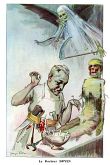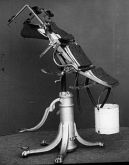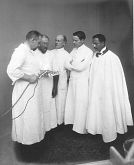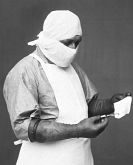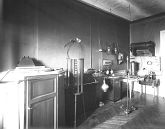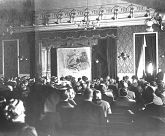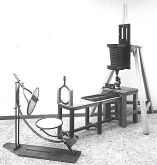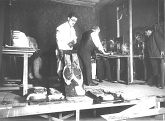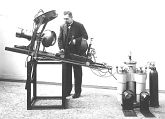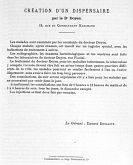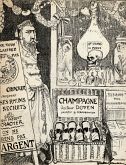
The Scandalous Dr Doyen, or the Solitary Tragedy of a Prodigy |
Introduction by Pr Jacques HM Cohen
Laboratoire d'Immunologie
CHU Robert Debré de Reims
Université de Reims Champagne-Ardenne
jacques.cohen@univ-reims.frTranslation by Karine Debbasch
Université Paris 5 René Descartes
karine.debbasch@parisdescartes.frJanuary 2006
Access to digitized documents
|
|
The surgical work of Dr Doyen
E.L. Doyen developed the idea of efficiency in surgical acts and of large blood vessels ligatures over the surgical field. As such, he invented a great number of dedicated instruments allowing quick, precise movements – an absolute necessity in his time, when anesthesia was dangerous and neither post-operative resuscitation nor artificial ventilation existed. For example, he replaced the twenty or so clamps that were required for a vaginal hysterectomy with Péan’s procedure with 5 ligatures on each side.
But paradoxically, his virtuosity went against the diffusion of his surgical techniques in his lifetime. E.-L. Doyen was endowed with rather exceptional eye/hand coordination that made him not only an excellent surgeon but also a sharpshooter (who once won a competition in Monaco) and a formidable fencer. The speed with which he could perform surgical acts became legendary. However, it also gave way to easy denigration by advocates of traditional procedures, who claimed that his methods could only be his own and never be adopted by common man. Nevertheless, the analyses of his writings and of his instruments turned out to be of great use to Anglo-Saxon pioneers after his death, for instance to implement valvular commissurotomy of the heart, which Doyen had unsuccessfully initiated.
E.-L. Doyen, who knew how to use a slide rule, and who also knew mechanics, physics and electricity better than most physicians and surgeons of his time, used them in his practice of the surgical art: he used radiography (but opposed curative radiotherapy) and electrocoagulation, having a preference for the use of currents allowing deep coagulation as opposed to the widely popular surface fulguration technique, which was preferable from a carcinological standpoint.
He used numerous pneumatic or even electrical devices, in particular for trephination and more generally cranial surgery, which he also initiated. He used electricity in carcinological mammary surgery to generate local heat in a flooded surgical field so as to obtain a temperature of 56°C (132°F) and thus destroy residual cancerous cells. He also performed other thermal destructions of tumors. It comes as no surprise that the only two surgeons who dared write favorable obituaries when Doyen died had also made important, innovative contributions: J.L. Faure in maxillo-facial surgery, and Toupet in rectal cancer surgery.
Doyen’s medical and biological work
In spite of his surgical talent, E.-L. Doyen believed that surgery was bound to disappear due to the progress of medicine; he therefore thought that research in physiopathology had priority. He wrote his dissertation on Cholera bacillus at the Institut Pasteur laboratory with Nocard, which at that time implied abandoning medicine – but Doyen refused to do so.
Indeed, Louis Pasteur offered him a position at the Institut Pasteur on the condition that he renounced treating patients, as he required his researchers to be committed full-time to their research.
E.-L. Doyen declined and left the institute. He did pursue research in biology, but his work was more and more solitary and difficult as the years went by because of conflicts with the Faculté de médecine / medical school and the academic institutions.
Ostracized as he was, it eventually became impossible for him to find respected collaborators willing to risk being ostracized themselves.
The Faculté finally was able to excommunicate E.-L. Doyen because of the way he treated cancer. At the time involved in cancer immunology research, he was planning to transplant a fragment of non-vascular breast cancer into the other breast of a patient to try and get an immune reaction as an adjuvant to surgery.
The Academy, keeping a close eye on Doyen, condemned the operation, declaring it vivisection performed by a mad scientist. Doyen had to cease his activity.
However, this patient was presenting a ninth local recurrence of breast cancer. Today, such a treatment would be justified as “compassionate care”, all the more so as the transplanted tumor had been treated at 56°C in an attempt to stop its own proliferative potential, 56°C being a temperature known to denature most enzymatic cell systems.
Later, Doyen believed he had discovered the etiological microorganism of cancer when he isolated a micrococcus associated with certain tumors. From this infectious agent, he prepared antisera and a vaccine that would naturally cause partial remission of some tumors through non-specific immune stimulation; Doyen therefore felt he was on the right track, whereas the Academy considered him to have definitely lost his mind.
Today we know quite a few viruses responsible for tumors, but bacterian examples in humans are limited to a rare tumor of the Andean cordillera due to bartonella bacilliformis. A recent experimental mouse model based on Helicobacter pylori as an etiological agent or co-agent of stomach cancer could bring E.-L. Doyen some kind of long overdue posthumous revenge.
The most important medical work of E.-L. Doyen was in the field of immunology. E.-L. Doyen, in the wake of Metchnikov, was persuaded that phagocytosis and antigen-nonspecific immunity were extremely important. He worked at stimulating the latter and perfected a yeast extract, which he called Mycolysine for human use and Phagédine for animal use. These products remained available on the market until World War II, in 1944, when the factory was destroyed. These products were quite efficient, as has been shown not only by clinical data, but also by experimental data obtained on rabbits in Metchnikov’s laboratory. Experiments on the inoculation of aphthous fever in cows revealed that administering this product reduced the loss in milk production by 50% (in an infected herd).
The use of phagocytosis immunostimulation of antigen nonspecific inflammatory reactions seems to date back to the Neolithic Era. It had a certain efficacy in chronic bacterial infections such as tuberculosis or brucellosis. E.-L. Doyen was among the very last to use it, before antibiotics sent these treatments back to prehistorical times… but not for long! Indeed, treating hepatitis C with interferon, or bladder cancers with BCG (as an adjuvant treatment), or renal cancers with interleukin 2, is, conceptually speaking, nothing less than a return to these therapeutics, with modern means.
The didactic work
E.-L. Doyen could perform operations without the approval of the Academy, but he was prevented from teaching, which was a source of great frustration for him. He therefore abundantly published (books and journal articles) and presented in numerous conferences. He was without question a forerunner in his understanding of the potential role of images (and cinematography) in teaching. Alone, he perfected an episcope for projecting anatomical sections, thus demonstrating knowledge in optics comparable to that of Zeiss's, where the world’s best specialists were then working.
He then became interested in photography, and he made thousands of didactic photographs, some of them color; unfortunately, almost everything disappeared in 1944 during the last German bombing of Paris. More importantly, Doyen was a trailblazer in medical cinematography. In 1913, he even attempted to create a stereoscopic color camera.
His black and white films soon became world-famous, but the Academy once again strongly objected, because they considered this filming as going against medical secret and surgical companionship. E.-L. Doyen also made an atlas of microbiology based on photomicroscopy.
He subsequently worked on a rather unusual anatomical atlas. E.-L. Doyen was an advocate of cross-sectional anatomy.
At the time, anatomical sections of the brain were used by neurologists in a new, non-surgical discipline, but surgical anatomists only really started using them long after Doyen: Rouvière, for instance, scattered anatomical sections throughout his classic work more than 15 years after Doyen had published his sectional anatomical atlas. For this he chose an uncompromising presentation, using nothing but photographed sections, sometimes colorized and presented with annotations, but without any typical anatomical views or simplified schema. Considering the surgical culture of the time, the book was not very accessible. The generalization of sectional anatomy with x-ray tomodensimeters and more importantly with magnetic resonance endows these plates with surprising modernity.
Doyen also was the editor-in-chief of the Revue Critique de Médecine et de Chirurgie, in which Babinski demolished his master Charcot's theories on the organicity of hysteria, and more importantly of the Archives de Doyen, the Doyen Institute journal, for which he worked as the tireless – and later practically the only – writer.
Doyen would hardly ever sleep, and never did he spend a whole night in a bedroom. He would sleep for a few hours on a sofa somewhere in his institute, which was also his home, would take a shower and summon his people to perform an operation, even at 3 in the morning. Conversely, he was liable to suddenly fall asleep, for instance in the middle of a conversation, which tends to suggest he might have suffered from an organic sleep disorder such as narcolepsy, although no similar disorder is known in his family.
The extra-medical scientific work
Indeed, the part of his work devoted to ballistics can hardly be considered as fully medical – ballistics studying the motion of projectiles meant to kill. Doyen's work in this field, far from being limited to the firing of bullets into cadavers, was quite important, and at one point involved a collaboration with Gustave Eiffel.
Doyen performed systematic tests of various calibers, from needle munitions to 12.5 mm bullets, and he established the opposition between perforation capacity and stopping power; he also studied the various types of damage. He used photography and cinematography to analyze the initial speed of the various bullets.
One cannot but notice that, once again, Doyen was right to have opposed the use of armored bullets, meant to perforate the armor of mounted soldiers, by squads firing from a distance of 800 meters (a favorite among the pre-World War I general staff). Instead, he frankly advocated employing a stronger stopping power from a shorter distance with soft-headed bullets, which would shatter rather than perforate.
Doyen's ballistic anatomical collections were important enough in the eyes of the Japanese general staff for them to involve an agent planted in Metchnikov's laboratory at the Institut Pasteur and at the Institut Doyen for several years: after Doyen's sudden death, he stole the whole collection and disappeared.
During World War I, as his native city, Reims, lay in shattered ruins, Doyen designed a mobile mortar on wheels, defining its diameter, tube length and munition proportion through systematic trials. As a result of this invention, he was posthumously winner of a call for proposal on new weapons launched by the General Staff in 1917. A pilot production of 2,000 tubes and of 100,000 munitions was ordered, but the weapon was not used on a large-scale basis before the end of World War I. But it does have a universal line of descent, as the parameters that Doyen defined for his 120 mm mortar are still used in almost every contemporary model. One may add that Doyen's competence in ballistics was used by the defendant lawyer Mr. Labori to counter the charges against Mrs. Caillot, who had shot Calmette, the director of Le Figaro, several times with a revolver. Doyen's analysis showed that the shots would not have been fatal if Calmette had been operated on sooner, and also that Mrs Caillot had emptied her gun without taking aim. This largely contributed to the acquittal of the defendant (although the members of the jury also considered Calmette's having published intimate letters written by the former Council President Caillot to his future wife to be a vile act calling for revenge).
Social and political work
Fig. 9 : Archives de Doyen, n° 2, Dec. 15, 1910, p. 116
To access the documentRejected and ostracized by the Academy, E.-L. Doyen practiced a policy of stardom and constantly being in the public eye, mixing with the “jet society” of his time and multiplying provocative acts and declarations. For instance, he declared that the attempt to install a General Medical Council was nothing but a timid or even Mafia-like corporatism. He also said that medical school teachers should not have private consultations anymore, but rather be paid for their teaching, and that in proportion to the number of students present in the amphitheater!
Besides the Institut Doyen, E.-L. Doyen opened some twenty clinics in Paris, mainly financed by his personal fortune, as was his research.
Unable to raise public charity funds, he instead required extremely high fees from his wealthy clientele.
Doctor Doyen's private life also did not correspond to the standards of discretion of the time. Opposed as he was to any type of secrecy, he divorced his wife, the mother of his three children, and led a tumultuous love life, without hiding the demi-mondaines he lived with, as his peers would have. He finally remarried an actress.
E.-L. Doyen once attempted a political adventure by standing for Parliament as a social republican, which today would be considered left-wing. He entered as ruthless a universe as that of the Medical Academy, and was soon accused of being a royalist because of his acquaintance with Albert I Prince of Monaco, a full-fledged scientist and founder of the Oceanographic Institutes of Monaco and Paris.
A free-mason and a free thinker, E.-L. Doyen nevertheless brought nuns into his clinic – his critics claimed that it was to save him money. He would often use evangelical parables and frequently repeated that people were not to “do unto others what they do not want done to themselves”. However, neither tolerance, nor magnanimity, nor charity in the intellectual acception of the term can be said to have been guiding principles of his life. Endowed as he was with natural, naive candidness, and with a hot temper that could lead him to cruelty towards those he despised, E.-L. Doyen must have suffered greatly from the paranoid loneliness to which he was condemned, as he really enjoyed society and teaching.
The social life in the spotlight he had staged for himself was probably nothing but a public persona, if not a kind of protection – something he probably also considered to be too time-consuming and utterly accessory when compared to his real passion: Medicine.
Click here to get more Doyen’s pictures
Grateful thanks to Jean Doyen who offered many pictures to illustrate our paper

